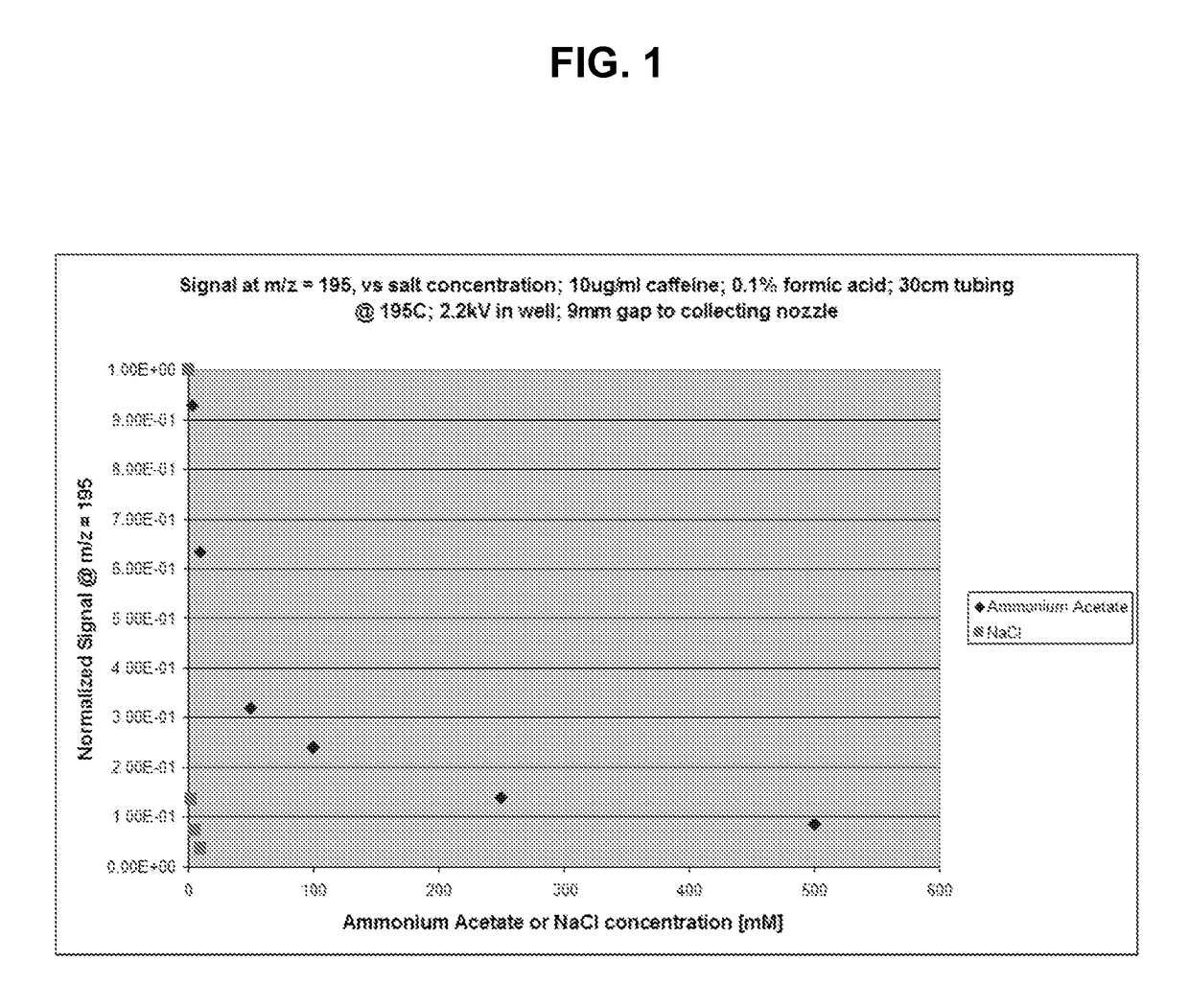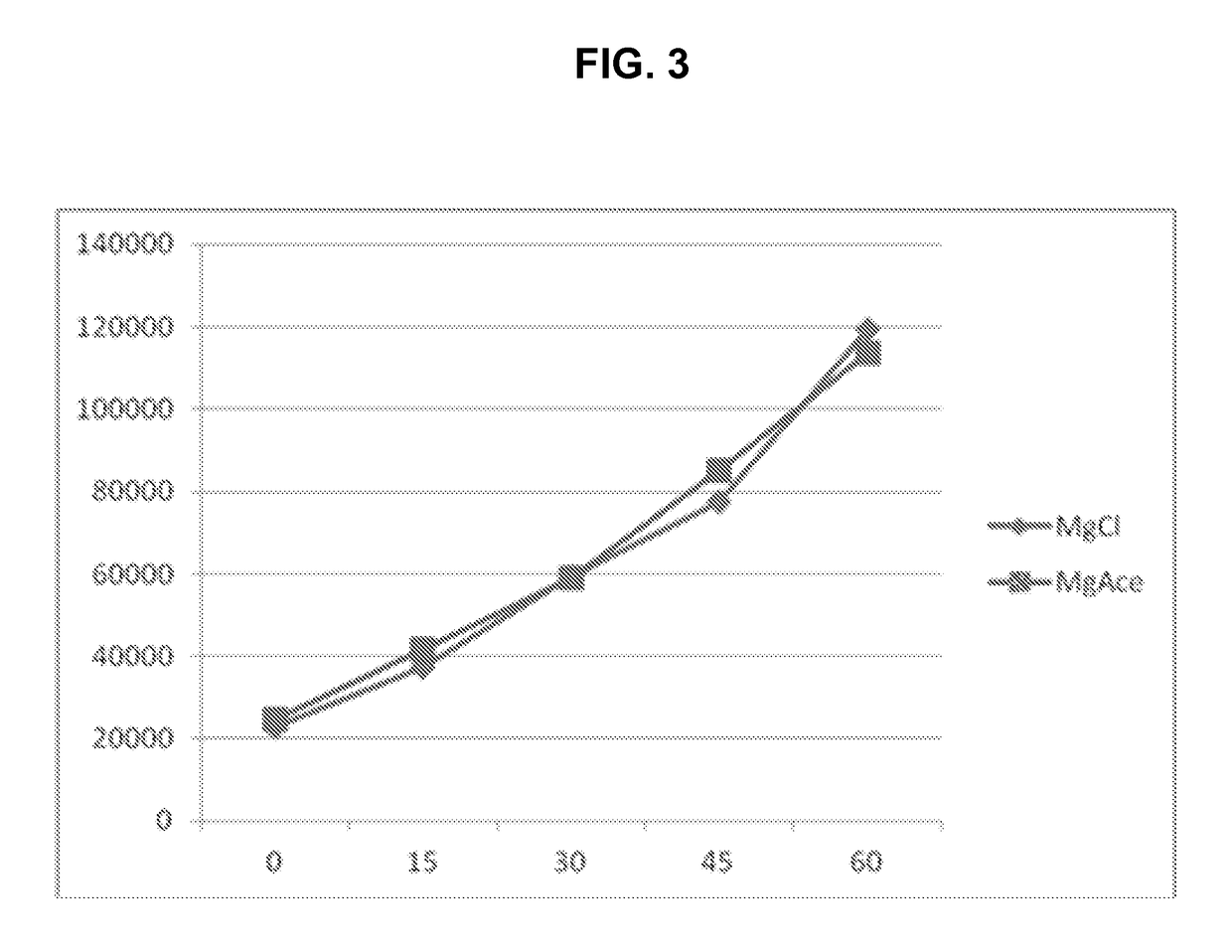Method and system for determining the concentration of an analyte in a fluid sample
a fluid sample and analyte technology, applied in the field of improved methods for detecting the presence or quantity of analyte in fluid sample, can solve the problems of interference with the analytical procedure, non-analyte species can be particularly problematic, and contaminants are evidently present in biological samples undergoing analysis, so as to achieve accurate determination of the concentration of analyte
- Summary
- Abstract
- Description
- Claims
- Application Information
AI Technical Summary
Benefits of technology
Problems solved by technology
Method used
Image
Examples
example 1
[0164]In this example, the impact of buffer volatility on the mass spectrometric determination of caffeine was evaluated using ammonium acetate as a volatile buffer salt and sodium chloride as a nonvolatile buffer salt. Fluid samples were prepared with varying concentrations of either ammonium acetate or sodium chloride, at 1 mM, 2 mM, 5 mM, 10 mM, 25 mM, 50 mM, 100 mM, 250 mM, and 500 mM. Sample droplets were generated using a modified Echo® 555 liquid handler (Labcyte Inc., Sunnyvale, Calif.). The instrument was modified to move the transducer assembly to the exterior of the instrument underneath a nozzle to allow the droplet stream to be exposed to 195° C. heat, thus enabling gas phase extraction of volatile salt, and pulled into a beta version of the SQ Detector II mass spectrometer (Waters Micromass).
[0165]FIG. 1 is a plot of normalized signal at m / z=195 versus ammonium acetate (♦) or sodium chloride (▪) concentration (mM). As may be seen, the concentration of caffeine detected...
example 2
[0167]This example describes an additional evaluation of the impact of buffer volatility on the mass spectrometric determination of caffeine, with magnesium acetate used as a volatile buffer salt and magnesium chloride as a nonvolatile buffer salt. The signal intensity of caffeine and its sodium adduct was evaluated in four concentrations of six salt systems. The data, plotted in FIG. 2, shows that standard ESI system sensitivity is heavily impacted by non-volatile salts and less impacted by a volatile salt, at similar concentrations. That is, the uppermost data points in the plot correspond to the signal obtained with fluid samples containing caffeine and ammonium acetate as a buffer salt. The experiment may be repeated to carry out mass spectrometric determinations of other analytes with substantially the same results.
example 3
[0168]In this example, a kinase assay was conducted in which magnesium is required by the enzyme used, and the assay measures the increase in concentration of a phosphorylated peptide substrate with time. One set of samples was formulated with magnesium chloride, a relatively nonvolatile compound, and a second set of samples was formulated with magnesium acetate, a more volatile compound. The assay results using each type of magnesium salt are illustrated in FIG. 3, in which time, in minutes, is represented on the X-axis, and luminescence is represented on the Y-axis. The graph comparing results obtained for the assay employing magnesium chloride (♦) with those obtained for the assay employing magnesium acetate (▪) show that the assay was not hindered or biased by the source of magnesium ions.
[0169]In many assay systems, certain non-volatile and / or highly electronegative buffer components are used; however, these components are not unique creating the biological or chemical outcome ...
PUM
| Property | Measurement | Unit |
|---|---|---|
| flow rate | aaaaa | aaaaa |
| temperature | aaaaa | aaaaa |
| temperature | aaaaa | aaaaa |
Abstract
Description
Claims
Application Information
 Login to View More
Login to View More - R&D
- Intellectual Property
- Life Sciences
- Materials
- Tech Scout
- Unparalleled Data Quality
- Higher Quality Content
- 60% Fewer Hallucinations
Browse by: Latest US Patents, China's latest patents, Technical Efficacy Thesaurus, Application Domain, Technology Topic, Popular Technical Reports.
© 2025 PatSnap. All rights reserved.Legal|Privacy policy|Modern Slavery Act Transparency Statement|Sitemap|About US| Contact US: help@patsnap.com



